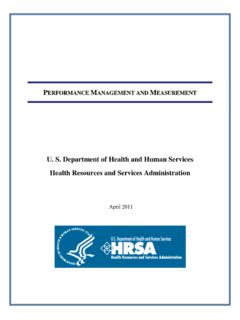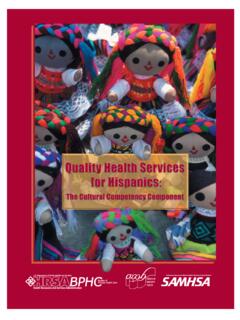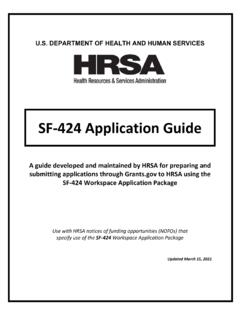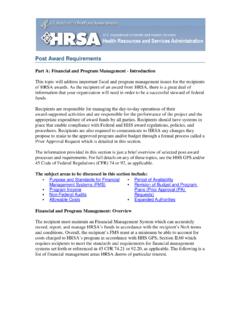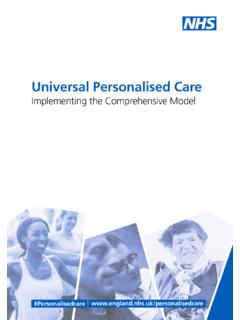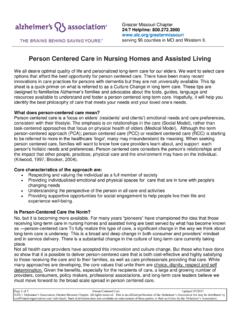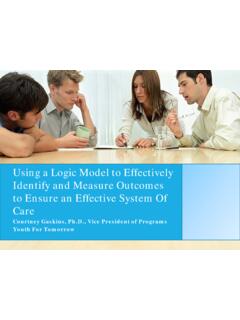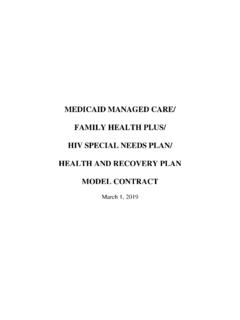Transcription of CENTERS FOR MEDICARE & MEDICAID SERVICES VALUE …
1 CENTERS FOR MEDICARE & MEDICAID SERVICES VALUE BASED care Jean D. Moody-Williams, RN, MPP Deputy Director, center for Clinical Standards and Quality CMS Strategic Goals Empower patients and clinicians to make decision about their health care Usher in a new era of state flexibility and local leadership Support innovative approaches to improve quality, accessibility, and affordability Improve the CMS customer experience 2 C. Q 20 18 16 14 c, 12 0 ~10 c .. ~ 8 ~ Healthcare Spending as a Percentage of GDP, 1960-2010 Source:OECO ~t12012 frequentl~ Acceswid2012-09-1018:20 0+-----~----~------------~--1960 1965 1970 1975 1980 1985 1990 1995 2000 2005 2010 Department of Health and Human SERVICES OFFICE OF INSPECTOR GENERAL ADVERSE E'VENTS IN HOSPITALS: ATIONAL INCIDENCE AMONG MEDICARE BENEFICIARIES Not too long ago - 1 in 7 about 1 in 7 experienced an adverse event 3 The Journey to VALUE Based care We must shift away from a fee-for-service system that reimburses only on volume and move toward a system that holds providers accountable for outcomes and allows them to innovate.
2 Providers need the freedom to design and offer new approaches to delivering c a re . Seema Verma, September 19, 2017 What does VALUE -based mean to CMS? How do we determine VALUE ? How do we empower patients, inspire competition, and encourage innovation? VALUE is determined by patients, not policy makers. This means we will need to empower patients by encouraging innovation and choice in where they get care . Making health care more about health and less about bureacracy. Seema Verma, July 10, 2018 4 What is VALUE Based care CMS currently defines VALUE -based care as paying for health care SERVICES in a manner that directly linksperformance on cost, quality and the patient's experience of care . Source: CMS VBP Affinity Group 5 What is VALUE -Based Purchasing?
3 Foundational principles of CMS VBP: -Alignment - VBP programs must be streamlined and aligned with one another -Accountability & Engagement - All stakeholders must be in this together; how we hold stakeholders responsible -Full Clinical Picture - Measures and weighting of measures must reflect full clinical picture of a patient, not just by setting; scoring methodology -Patient-Centered Framework - VBP programs must be developed within a patient centered framework -Health Information Technology and Interoperability Health Information Technology must be nimble, aligned, focused on agreed upon goals and interoperable; accurate, high-quality data must the priority forany quality improvement work -Population Based Approach - A population based approach must be taken incorporated, not just an individual patient/procedure approach - VALUE /Efficiency - Quality and cost must be linked -Data Accessibility - Providers should have real-time access to data and feedback on their performance.
4 -Adaptability to Evolving Payment Models - IT systems, processes and internal operations must evolve and be able to support the evolving payment models. -Provider Incentives/Timeliness - Improve incentives to encourage providers to submit claims in a timelymanner, align timelines across programs, and give timely feedback. 6 CATEGORY1 FEE-FOR-SERVICE -INO LINK TO QUALITY & VALUE Figure 1: The Updated APM Framewor'k CAT EGORY2 FEE-FOR-SERVICE -LIINK TO QUALITY & VALUE A Foundational Payments for !Infrastructure & Operations ( , care ina on fees and paymen s for healt h information logy invest ment s) B Pay for Reporting ( , onuses for reporting data o r penalties for no repor ng dat a) C Pay-for-Performance ( , b onuses for quality per ormance) CATEGORY3 APMS BUILT O N FEE-FOR-SERVICE ARCHITECTURE A A PMs with Shared Savings ( , shared sav ings wit h u pside risk o n ly) B A PMs wit h Shared Savings and Downside Risk ( , episod e- based payment s 'or procedures and comprehensive paymen s wit h upside and downside r is )
5 3N Ris k Based Paym e n t s NOT Lin ke d to Qua lit y CATEGORY4 POPULAT O N-BASED PAYMENT A Condition-Specific Population- Based Payme nt ( , per me m er per mont h paym e nts, paymen s for s cialt y SERVICES , such as o n cology or me nt al ealt h) B Comprehensive Population- Based Payment ( , global budgets or full/percen of prem ium paymen s) C Integrated Finance & DeHvery Systems ( , global budgets or full/percen o p remium payment s in integrated sys ems) 4N Cap itated Payments INO T Linked to Q ua lity Currently Acknowledged Categories of VALUE Based care Movement to VALUE includes the progression from from fee-for-service payments to integrated paymentmodels such as MEDICARE Advantage or Alternative Payment Models.
6 Currently accepted progression pathways from MEDICARE and Commercial Payers are listed below. MIPS is a Category 2 program with the potential of improving care and serving as a gateway to category 3 and 4. The Health care Payment Learning & Action Network (LAN) , Alternative Payment model (APM) Framework, Updated July 2017 7 VALUE -Based Purchasing at CMSVBP Programs & Models CMS VBP Programs 1. End-Stage Renal Disease (ESRD) Quality Incentive Program (QIP) 2. Hospital-Acquired Condition (HAC) Reduction Program (HACRP) 3. Hospital Readmissions Reduction Program (HRRP) 4. Hospital VALUE -Based Purchasing (VBP) Program 5. Marketplace Quality Initiatives: Quality Improvement Strategy (QIS) 6.
7 Marketplace Quality Initiatives: Quality Rating System (QRS) 7. MEDICAID 1115 Demonstrations 8. MEDICARE Shared Savings Program 9. Quality Payment Program (QPP) 10. Skilled Nursing Facility (SNF) VALUE -Based Purchasing (VBP) Program 11. VALUE Modifier Program center for MEDICARE and MEDICAID Innovation (CMMI) VBP Models 12. Accountable care Organization (ACO) Investment model (AIM) 13. Accountable Health Communities (AHC) model 14. Bundled Payments for care Improvement (BPCI) Advanced 15. Comprehensive care for Joint Replacement (CJR) model 16. Comprehensive End Stage Renal Disease (ESRD) care (CEC) model 17. Comprehensive Primary care Plus (CPC+) 18. Episode Payment Models (EPMs) 19. MEDICARE - MEDICAID Financial Alignment Initiative 20. Health care Innovation Awards Round Two 21.
8 Home Health VALUE -Based Purchasing (HHVBP) model 22. Independence at Home model 23. Maryland All-Payer model [Non-QPP APM] 24. MEDICAID Innovation Accelerator Program (IAP) 25. MEDICARE Accountable care Organization (ACO) Track 1+ model 26. MEDICARE Advantage VALUE -Based Insurance Design (VBID) model 27. MEDICARE care Choices model 28. Million Hearts Cardiovascular Disease Risk Reduction model 29. Multi-Payer Advanced Primary care Program 30. Next Generation Accountable care Organization (NGACO) model 31. Oncology care model (OCM) 32. Part D Enhanced Medication Therapy Management model 33. Pennsylvania Rural Health model 34. State Innovation Models Initiative 35. Strong Start for Mothers & Newborns Initiative: Enhanced Prenatal care Models 36. Transforming Clinical Practice Initiative (TCPI) 37.
9 Vermont All-Payer Accountable care Organization (ACO) model 8 .. ,, fOH: MU>ICAMI;. & MIEDICAII> :.EMVICl:S - Meaningful Measures Initiative Launched in 2017, the purpose of the Meaningful Measures initiative is to: Improve outcomes for patients Reduce data reporting burden and costs on clinicians and other health care providers Focus CMS s quality measurement and improvement efforts to better align with what is most meaningful to patients 9 .. ,, fOH: MU>ICAMI;. & MIEDICAII> :.EMVICl:S -,_ I , M Meaningful Measures Objectives Meaningful Measures focus everyone s efforts on the same quality areas and lend specificity to help identify measures that: Address high-impact Are patient-centered Are outcome-based Fulfill requirements measure areas that and meaningful to patients, where possible in programs statutes safeguard public health clinicians and providers Identify significant Minimize level of Address measure Align across programs burden for providers opportunity for needs for population and/or with other payers improvement based payment through alternative payment models 10 ,, fOH: MU>ICAMI.
10 & MIEDICAII> :.EMVICl:S Improve Access for Rural Communities .. - .. Reduce Burden Eliminate Disparities Improve CMS Customer Experience Support State Flexibility and Local Leadership Support Innovative Approaches Empower Patients and Doctors Achieve Cost Savings Safeguard Public Health - -. Track to Measurable Outcomes and Impact @ Promote Effective Communication & Coordination of care Meaningful Measure Areas: Medication Management Admissions and Readmissions to Hospitals Transfer of Health Information and Interoperability 0 Promote Effective Prevention & Treatment of Chronic Disease Meaningful Measure Areas: Preventive care Management of Chronic Conditions .. Prevention, T reatment, and Management of Mental Health 0 0 Prevention and Treatment of Opioid and Subst a nce Use D isorde r s Risk Adjusted Mortalit y Work with Communities to Promote Best Practices of Healthy Living Meaningful Measure Areas: Equity of Car e Community Engagement Make care Affordable Meaningful Measure Areas: Appropriat e Use of Healthcare Patient-focused Episode of care Risk Adjusted Total Cost of care Make care Safer by Reducing Harm Caused in the Delivery of care Meaningful Measure Areas: Healt hcare-associated Infections Preventable Healthcare Harm 0 Strengthen Person & Family Engagement as Partners in their care Meaningful Measure Areas.
